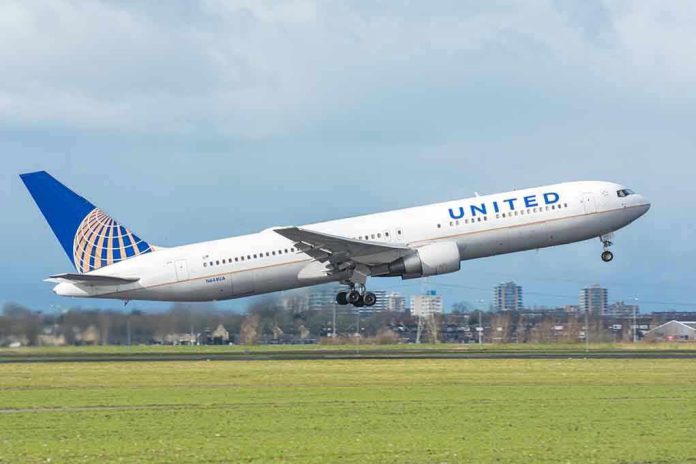
One man’s chilling bomb threat aboard a routine flight triggered an emergency landing, a full-scale evacuation, and a cascade of security questions that still hang over America’s airports.
Story Snapshot
- A United Airlines flight from Dallas to Chicago made an emergency landing in St. Louis after a bomb threat.
- The suspect, a 26-year-old male, claimed the bomb was in his wife’s luggage, prompting a rapid evacuation.
- No bomb was found, no injuries were reported, but authorities conducted a thorough search and arrested the suspect.
- The event exposed vulnerabilities in U.S. aviation security protocols and sparked renewed debate about passenger screening and response.
How One Threat Turned Routine Travel Into Crisis
United Airlines flight UA380 lifted off from Dallas on a quiet Sunday morning, carrying dozens of passengers expecting an uneventful trip to Chicago. Forty minutes into the journey, the cabin’s calm fractured when a man reportedly declared there was a bomb in his wife’s luggage. Pilots, faced with the prospect of catastrophe, declared an emergency and diverted the Boeing 737-700 to St. Louis Lambert International Airport. Within minutes, the aircraft made a safe landing on runway 29, but the ordeal for passengers had only begun.
The bomb threat set off a textbook emergency response. Airport authorities and law enforcement converged on the runway, overseeing a rapid evacuation of the aircraft. Passengers and crew were ushered to the B concourse for safety. The suspect, a 26-year-old male, was arrested on the spot. While fear and confusion rippled through the crowd, the bomb and arson unit swept the plane, ultimately finding no evidence of explosives or suspicious devices. The threat, though false, left a deep mark on everyone involved.
Unraveling Motives and Aviation Security Protocols
The incident presents a complex puzzle for investigators. The suspect’s motive remains uncertain, with law enforcement continuing to probe why he made the claim about his wife’s luggage. This ambiguity has fueled speculation and concern among both passengers and the broader flying public. United Airlines, responsible for the flight’s operation and safety, followed established emergency procedures, but the disruption highlights persistent vulnerabilities in how threats are managed in midair.
Airport director Rhonda Hamm-Niebruegge praised the swift, coordinated response that ensured no one was injured. The bomb threat forced a temporary halt to operations at Lambert St. Louis International Airport, causing delays and logistical headaches for staff and travelers. Despite the absence of physical harm, the psychological impact and heightened anxiety lingered long after the aircraft was cleared.
Ripple Effects Across the Aviation Industry
Events like these raise tough questions about the balance between passenger convenience and security. While bomb threats on commercial flights remain statistically rare, experts note a recent uptick in disruptive behavior and false alarms on U.S. carriers. Heightened passenger volumes post-pandemic, combined with new patterns of unrest, have stretched security protocols to their limits. Airports and airlines face mounting pressure to reassess how threats are detected and managed, including potential changes to screening procedures and emergency response drills.
The impact extends beyond just the day’s disrupted flights. Passengers on UA380 must now grapple with lingering anxiety about future travel. United Airlines faces reputation management challenges, while Lambert staff contend with the aftershocks of a major emergency. The broader aviation sector is again forced to confront hard realities: how to maintain rigorous security without paralyzing routine operations, and whether current protocols sufficiently protect the public from unpredictable threats.
Expert Analysis: Security, Psychology, and the Road Ahead
Aviation security experts point to the importance of fast, coordinated response in minimizing harm, but warn that no system is foolproof. The psychological toll on passengers and crew, though often overlooked, is substantial and may require new approaches to mental health support and crisis management. Law enforcement officials stress ongoing vigilance, arguing that every threat—real or hoax—must be treated with the utmost seriousness until proven otherwise.
Industry leaders and academic commentators offer contrasting viewpoints. Some advocate for stricter passenger screening and pre-boarding assessments, citing the need to deter future incidents. Others caution against overreacting to isolated events, reminding the public that air travel remains overwhelmingly safe and secure. What is clear is that incidents like the UA380 bomb threat reignite critical debates about aviation safety—and leave open questions that demand thoughtful answers from policymakers, airlines, and travelers alike.



